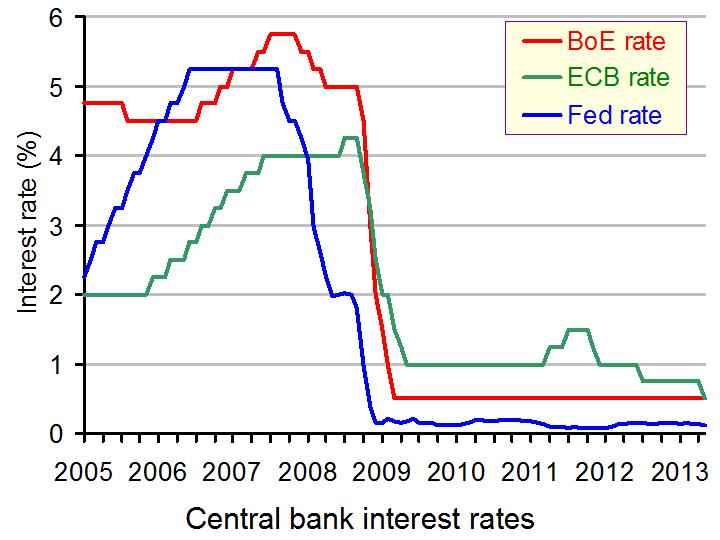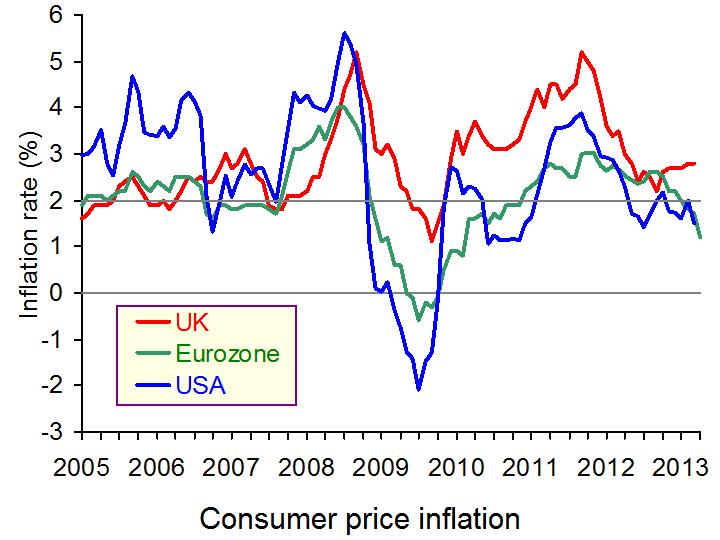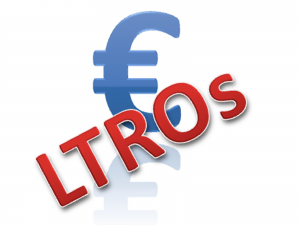 Interest rates have, for some years, been the main tool of monetary policy and of steering the macroeconomy. Across the world interest rates were lowered, in many cases to record lows, as a means of stimulating economic growth. Interest rates in the UK have been at 0.5% since March 2009 and on 2nd May 2013, the ECB matched this low rate, having cut its main interest rate from 0.75%. (Click here for a PowerPoint of the chart.)
Interest rates have, for some years, been the main tool of monetary policy and of steering the macroeconomy. Across the world interest rates were lowered, in many cases to record lows, as a means of stimulating economic growth. Interest rates in the UK have been at 0.5% since March 2009 and on 2nd May 2013, the ECB matched this low rate, having cut its main interest rate from 0.75%. (Click here for a PowerPoint of the chart.)
Low interest rates reduce the cost of borrowing for both firms and consumers and this in turn encourages investment and can boost consumer expenditure. After all, when you borrow money, you do it to spend! Lower interest rates will also reduce the return on savings, again encouraging spending and for those on variable rate mortgages, mortgage payments will fall, increasing disposable income. However, these above effects are dependent on the banks passing the ECB’s main interest rate on its customers and this is by no means guaranteed.
Following the cut in interest rates, the euro exchange rate fell almost 2 cents against the dollar.
Interest rates in the eurozone have been at 0.75%, but a 0.25 point cut was widely expected, with the ongoing debt crisis in the Eurozone continuing to adversely affect growth and confidence. A lack of trust between banks has also contributed to a lack of lending, especially to small and medium sized enterprises. The ECB has injected money into financial institutions with the aim of stimulating lending, but in many cases, banks have simply placed this extra money back with the ECB, rather than lending it to other banks or customers. The fear is that those they lend to will be unable to repay the money. In response to this, there have been suggestions of interest rates becoming negative – that is, if banks want to hold their money with the ECB they will be charged to do it. Again, the idea is to encourage banks to lend their money instead.
Small and medium sized businesses have been described as the engine of growth, but it is these businesses who have been the least able to obtain finance. Without it, they have been unable to grow and this has held back the economic recovery. Indeed, GDP in the Eurozone has now fallen for five consecutive quarters, thus prompting the latest interest rate cut. A key question, however, will be how effective this quarter of a percent cut will be. If banks were unwilling to lend and firms unwilling to invest at 0.75%, will they be more inclined at 0.5%? The change is small and many suggest that it is not enough to make much of a difference. David Brown of New View Economics said:
The ECB rate cut is no surprise as it was well flagged by Draghi at last month’s meeting. Is it enough? No. The marginal effect of the cut is very limited, but at least it should have some symbolic rallying effect on economic confidence.
This was supported by Howard Archer at HIS Global Insight, who added:
Admittedly, it is unlikely that the trimming of interest rates from 0.75% to 0.5% will have a major growth impact, especially given fragmented credit markets, but any potential help to the eurozone economy in its current state is worthwhile.
 Inflation in the eurozone is only at 1.2%, which is significantly below the ceiling of 2%, so this did give the ECB scope for the rate to be cut. (Click here for a PowerPoint of the chart.) After all, when interest rates fall, the idea is to boost aggregate demand, but with this, inflation can emerge. Mr Draghi said ‘we will monitor very closely all incoming information, and assess any impact on the outlook for price stability’. The primary objective of the ECB is the control of inflation and so had inflation been somewhat higher, we may have seen a different decision by the ECB. However, even then, 5 consecutive quarters of negative growth is hard to ignore.
Inflation in the eurozone is only at 1.2%, which is significantly below the ceiling of 2%, so this did give the ECB scope for the rate to be cut. (Click here for a PowerPoint of the chart.) After all, when interest rates fall, the idea is to boost aggregate demand, but with this, inflation can emerge. Mr Draghi said ‘we will monitor very closely all incoming information, and assess any impact on the outlook for price stability’. The primary objective of the ECB is the control of inflation and so had inflation been somewhat higher, we may have seen a different decision by the ECB. However, even then, 5 consecutive quarters of negative growth is hard to ignore.
So, if these lower interest rates have little effect on stimulating an economic recovery, what about a movement away from austerity? Many have been calling for stimulus in the economy, arguing that the continuing austerity measures are stifling growth. The European Council President urged governments to promote growth and job creation. Referring to this, he said:
Taking these measures is more urgent than anything … After three years of firefights, patience with austerity is wearing understandably thin.
However, Mr. Draghi urged for policymakers to stick with austerity and continue to focus on bringing debt levels down, while finding other ways to stimulate growth, including structural reform. The impact of this latest rate cut will certainly take time to filter through the economy and will very much depend on whether the 0.5% interest rate is passed on to customers, especially small businesses. Confidence and trust within the financial sector is therefore key and it might be that until this emerges, the eurozone itself is unlikely to emerge from its recession.
ECB ready to enter unchartered waters as bank cuts interest rate to fresh low of 0.5pc The Telegraph, Szu Ping Chan (2/5/13)
Draghi urges Eurozone governments to stay the course on austerity Financial Times, Michael Steen (2/5/13)
Eurozone interest rates cut to a record low of 0.5% The Guardian, Heather Stewart (2/5/13)
ECB’s Draghi ‘ready to act if needed’ BBC News (2/5/13)
Eurozone interest rates cut again as ECB matches Bank of England Independent, Russell Lynch (3/5/13)
Margio Draghi urges no let-up in austerity reforms after Eurozone rate cut – as it happened The Guardian, Graeme Wearden (2/5/13)
ECB cuts interest rate to record-low 0.5% in desperate measure to drag Eurozone out of recession Mail Online, Simon Tomlinson and Hugo Duncan (2/5/13)
ECB cuts interest rates, open to further action Reuters, Michael Shields (2/5/13)
Eurozone loosens up austerity, slowly Wall Street Journal (2/5/13)
ECB cuts interest rate, not enough to pull the region out of recession The Economic Times of India (2/5/13)
Euro steady ahead of ECB interest rate announcement Wall Street Journal, Clare Connaghan (2/5/13)
 European Central Bank (ECB) cuts interest rates BBC News (2/5/13)
European Central Bank (ECB) cuts interest rates BBC News (2/5/13)
All eyes on ECB as markets expect rate cut Financial Times, Michael Steen (2/5/13)
Questions
- How is a recession defined?
- Using an aggregate demand/aggregate supply diagram, illustrate and explain the impact that this cut in interest rates should have.
- On which factors will the effectiveness of the cut in interest rates depend?
- Using the interest rate and exchange rate transmission mechanisms to help you, show the impact of interest rates on the various components of aggregate demand and thus on national output.
- What would be the potential impact of a negative interest rate?
- Why did the low inflation rate give the ECB scope to cut interest rates?
- What are the arguments for and against austerity measures in the Eurozone, given the 5 consecutive quarters of negative growth?
 The ECB president, Mario Draghi, has announced a new programme of ‘Outright Monetary Transactions (OMTs)’ to ease the difficulties of countries such as Greece, Spain, Portugal and Italy. The idea is to push down interest rates for these countries’ bonds. If successful, this will make it more affordable for them to service their debts.
The ECB president, Mario Draghi, has announced a new programme of ‘Outright Monetary Transactions (OMTs)’ to ease the difficulties of countries such as Greece, Spain, Portugal and Italy. The idea is to push down interest rates for these countries’ bonds. If successful, this will make it more affordable for them to service their debts.
OMTs involve the ECB buying these countries’ bonds on the secondary market (i.e. existing bonds). This will be limited to bonds with no more than three years to maturity. Although restricting purchases to the secondary market would not involve the ECB lending directly to these countries, the bond purchases should push down interest rates on the secondary market and this, in turn, should allow the countries to issue new bonds at lower rates on the primary market.
The OMT programme replaces the previous Securities Markets Programme (SMP), which began in May 2010. This too involved purchasing bonds on the secondary market. By the time of the last actions under SMP in January 2012, €212 billion of purchases had been made. Unlike the SMP, however, OMTs are in principle unlimited, with the ECB president, Mario Draghi, saying that the ECB would do ‘whatever it takes’ to hold the single currency together. This means that it will buy as many bonds on the market as are necessary to bring interest rates down to sustainable levels.
Critics, however, argue that this will still not be enough to stimulate the eurozone economy and help bring countries out of recession. They give two reasons.
The first is that OMTs differ from the quantitative easing programmes used in the UK and USA. OMTs would not increase the eurozone money supply as the ECB would sell other assets to offset the bond purchases. This process is known as ‘sterilisation’, which is defined as actions taken by a central bank to offset the effects of foreign exchange flows or its own bond transactions so as to leave money supply unchanged.
The second reason is that OMTs will be conducted only if countries stick to previously agreed strong austerity measures. This is something that it looking increasingly unlikely as protests against the cuts mount in countries such as Greece and Spain.
Articles
Super Mario to the rescue Financial Standard, Benjamin Ong (7/9/12)
Outright monetary transactions: Lowdown on bond-buying scheme Irish Times, Dan O’Brien (7/9/12)
Draghi comments at ECB news conference Reuters (6/9/12)
ECB’s Mario Draghi unveils bond-buying euro debt plan BBC News (6/9/12)
ECB Market Intervention: Outright Monetary Transactions (“OMT”) – A Preliminary Assessment Place du Luxembourg (9/9/12)
Evaluating the OMT: OrlMost Too late? Social Europe Journal, Andrew Watt (7/9/12)
Mario Draghi speech: what the analysts said The Telegraph (6/9/12)
ECB challenges German concern over bond-buying Irish Times, Derek Scally (26/9/12)
Draghi: efforts helping to support stable future MarketWatch, Tom Fairless (25/9/12)
 Mario and Mariano versus the man with the beard BBC News, Paul Mason (6/9/12)
Mario and Mariano versus the man with the beard BBC News, Paul Mason (6/9/12)
Good week for the euro – but also a warning BBC News, Stephanie Flanders (12/9/12)
The price of saving the eurozone BBC News, Robert Peston (26/9/12)
Special Report – Inside Mario Draghi’s euro rescue plan Reuters, Paul Carrel, Noah Barkin and Annika Breidthardt (25/9/12)
ECB to face biggest test on euro gambit Financial Times, Michael Steen and Peter Spiegel (25/9/12)
Press release
ECB: Monetary policy decisions ECB Press Release, (6/9/12)
Questions
- What are the key features of the OMT programme? How does it differ from the former Securities Markets Programme (SMP)?
- In what ways does the OMT programme differ from the quantitative easing programmes in the USA and UK?
- How will the ECB’s buying bonds in the secondary market influence the primary bond market? What will influence the size of the effect?
- How does sterilisation work in (a) the bond market; (b) the foreign exchange market?
- Why is it claimed that the OMT programme is a necessary but not sufficient condition for solving the crisis in the eurozone? What additional measures would you recommend and why?
- What are the risks associated with the OMT programme?
 The press is buzzing with talk of Greece leaving the euro. And if Greece leaves, what next? The press is also buzzing with talk of a possible, if not probable, breakup of the euro altogether – a Eurodämmerung as Paul Krugman calls it.
The press is buzzing with talk of Greece leaving the euro. And if Greece leaves, what next? The press is also buzzing with talk of a possible, if not probable, breakup of the euro altogether – a Eurodämmerung as Paul Krugman calls it.
So is Greece likely to leave the euro, or will the Greek electorate vote next time for the parties supporting the austerity package they negotiated with the EU?
If Greece does leave the euro, what would be the implications for the Greek economy? And what would be the implications for the rest of the eurozone? Would it fall apart: would there a be a domino effect to Spain, Portugal, Italy and Ireland and then the whole eurozone? Or would Germany and the ECB do whatever was necessary to prevent any more countries leaving?
The following articles ponder these weighty questions. In the meantime, stock markets around the world have plunged on fears of the damage a disorderly Greek exit could do to the eurozone and to the global economy.
Greece, euro exit and the drummer in the band Reuters, Luke Baker (14/5/12)
Greek fire could singe rest of euro Financial Times, Richard Milne and Patrick Jenkins (14/5/12)
Eurozone: If Greece goes … Financial Times, Chris Giles, Peter Spiegel and Kerin Hope (13/5/12)
How would Greece leave the euro? BBC News, Kabir Chibber (10/5/12)
 CBI: Greece eurozone exit ‘would be like an earthquake happening’ The Telegraph, John Cridland (14/5/12)
CBI: Greece eurozone exit ‘would be like an earthquake happening’ The Telegraph, John Cridland (14/5/12)
Forget what you’re hearing: Greece won’t quit euro soon Globe and Mail (Canada), Brian Milner (14/5/12)
Could the euro survive a Greek exit? BBC News, Robert Peston (14/5/12)
Greekonomics (see also) BBC News, Paul Mason (9/5/12)
This is how the euro ends – not with a whimper but a bang The Telegraph, Jeremy Warner (15/5/12)
EC and ECB working on emergency plans for Greek euro exit, says trade commissioner Karel De Gucht The Telegraph (18/5/12)
Fiddling while Athens burns The Economist (19/5/12)
Exodus, chapter 1 The Economist (19/5/12)
The Greek run The Economist (19/5/12)
Greece will leave the euro. But what then? Independent on Sunday, Hamish McRae (20/5/12)
No quick fix for Euro – maybe a slow one? BBC News, Stephanie Flanders (24/5/12)
Questions
- If Greece left the euro, what would happen to bank deposits in Greek banks?
- What would be the costs and benefits to the Greek economy of a reintroduction of the drachma?
- Why might individuals and companies, if they were able, move their euro deposits out of Spain, Portugal, Ireland and Italy into accounts based in other eurozone countries? What would be the implications of such financial flows?
- What can the ECB do to support the banking systems in vulnerable eurozone countries? Is there any theoretical limit to the amount that the ECB can offer?
- What is the role of the central banks of individual eurozone countries in a transfer of large-scale funds from one eurozone country to another? How does this impact on the receiving country (e.g. Germany)?
 In December 2011, the ECB provided some €489bn to banks in the form of three-year loans at low interest rates (1%) through open-market operations (see Will new ECB repo operations support the eurozone bond market?).
In December 2011, the ECB provided some €489bn to banks in the form of three-year loans at low interest rates (1%) through open-market operations (see Will new ECB repo operations support the eurozone bond market?).
These ‘Longer-term refinancing operations’ or ‘LTROs’ are designed to ease the burden on European banks which have been struggling to persuade markets that they are dealing with their large amounts of toxic debt, some of which is sovereign debt. Indeed, some of the ECB loans have been used to purchase Italian and Spanish bonds, thereby reducing the likelihood that these countries will default on their debts – at least for the timebeing.
On 29 February 2012, the ECB offered another round of LTROs. Some 800 banks borrowed €530bn under the scheme, bringing the total to a little over €1tr. Initially, much of the money has been put back on overnight deposit with the ECB. The hope, however, is that the loans will be used to support increased credit throughout the eurozone and to fund further purchases of sovereign debt.
But will the increased narrow money supply in the eurozone through these open-market operations result in increased broad money and increased spending and growth? The answer to that depends a great deal on confidence: confidence of banks to lend to firms and consumers; confidence of firms and consumers to borrow. The hope is that the extra money supply will not simply see a corresponding reduction in the velocity of circulation.
The following articles consider the likely effects of these longer-term repos on the real economy.
Articles
ECB hands €529bn in emergency loans to European banks Guardian, Heather Stewart (29/2/12)
Q&A: The ECB’s bank funding programme The Telegraph, Angela Monaghan (29/2/12)
Fighting Debt with Debt Forbes, Bob McTeer (5/3/12)
Is ECB’s €1trn cash boost just the tip of the iceberg? Investment Week, Kyle Caldwell, Dan Jones (5/3/12)
Banks deposit record €821bn at ECB Financial Times, Mary Watkins (5/3/12)
Europe economy may see slim gain from supersize funding: poll Reuters, Sumanta Dey (5/3/12)
Who is the ECB helping? BBC News, Stephanie Flanders (29/2/12)
ECB information on OMOs
Open Market Operations ECB
Questions
- Explain how longer-term refinancing operations work.
- What will determine how much of these ECB loans will be lent to companies?
- Explain what is meant by (a) the velocity of circulation; (b) the money multiplier. Why will the size of these two determine the likely success of the ECB’s LTRO programme?
- Why may the ECB’s actions boost market sentiment? Why might they have the opposite effect?
- Explain what is meant by the “continued de-leveraging by banks”. How does this impact on the money multiplier?
The European Central Bank does not provide direct support to eurozone countries by buying new bonds. However, it can give indirect support by helping banks buy such bonds. In a move announced on 8 December, the ECB will increase the maximum term of its ‘longer-term refinancing operations’ (LTROs) from the current 13 months to three years. In other words, it will effectively provide three-year loans to banks by purchasing banks’ assets on a ‘repurchase (repo)’ basis, whereby banks agree to buy back the assets at the end of the three-year term.
The hope is that banks will use these loans (at an annual rate of 1%) to purchase new bonds from countries such as Italy and Spain. If banks are more willing to buy them, this should help reduce the interest rate at which governments are forced to borrow. Banks would benefit from the ‘carry trade’, whereby they borrow at a low interest rate (from the ECB) and lend at a higher rate to governments by buying their bonds.
To encourage banks to take advantage of these new longer-term repos,the ECB announced that the assets it was prepared to purchase would include securitised assets with a rating of single A (the highest rating is AAA). In other words, it would accept assets with a ‘second-best rating’.
But although the scheme would allow banks to make a clear gain from a carry trade, banks may be reluctant to use such loans to increase their holdings of sovereign debt of countries with large debt to GDP ratios, given concerns in the market about the riskiness of such assets.
Articles and podcast
ECB repo extension a fillip for sovereigns Financial News, Matt Turner (15/12/11)
Doubts over ECB move to boost bond sales Financial Times, Tracy Alloway (15/12/11)
ECB Chief Plays Down Hopes for Bigger Bond Purchases Wall Street Journal, Tom Fairless And Margit Feher (15/12/11)
 Eurozone crisis ‘misdiagnosed’ BBC Today Programme, George Magnus (16/12/11) (second part of podcast)
Eurozone crisis ‘misdiagnosed’ BBC Today Programme, George Magnus (16/12/11) (second part of podcast)
Banks snap up €500bn in loans from European Central Bank Guardian. Larry Elliott (22/12/11)
Analysis: ECB cash to give indirect boost via banks Reuters, Natsuko Waki and Steve Slater (22/12/11)
Demand for ECB loans rises to €489bn Financial Times, Tracy Alloway and Ralph Atkins (21/12/11)
 ECB’s rescue of eurozone banks is temporary BBC News, Robert Peston (21/12/11)
ECB’s rescue of eurozone banks is temporary BBC News, Robert Peston (21/12/11)
ECB Press release
ECB announces measures to support bank lending and money market activity ECB (8/12/11)
Questions
- Explain how repos work. What is the difference between repos and reverse repos?
- What is meant by the term ‘carry trade’?
- Why may banks be unwilling to gain from the carry trade possibilities of the ECB’s new 3-year LTROs by using them to fund the purchase of new sovereign bonds? What risks are entailed by their doing so?
- How do these new long-term repo operations differ from quantitative easing? Explain whether or not the effect is likely to be similar
- What are the arguments for and against the ECB engaging in a round of substantial quantitative easing?
 Interest rates have, for some years, been the main tool of monetary policy and of steering the macroeconomy. Across the world interest rates were lowered, in many cases to record lows, as a means of stimulating economic growth. Interest rates in the UK have been at 0.5% since March 2009 and on 2nd May 2013, the ECB matched this low rate, having cut its main interest rate from 0.75%. (Click here for a PowerPoint of the chart.)
Interest rates have, for some years, been the main tool of monetary policy and of steering the macroeconomy. Across the world interest rates were lowered, in many cases to record lows, as a means of stimulating economic growth. Interest rates in the UK have been at 0.5% since March 2009 and on 2nd May 2013, the ECB matched this low rate, having cut its main interest rate from 0.75%. (Click here for a PowerPoint of the chart.) Inflation in the eurozone is only at 1.2%, which is significantly below the ceiling of 2%, so this did give the ECB scope for the rate to be cut. (Click here for a PowerPoint of the chart.) After all, when interest rates fall, the idea is to boost aggregate demand, but with this, inflation can emerge. Mr Draghi said ‘we will monitor very closely all incoming information, and assess any impact on the outlook for price stability’. The primary objective of the ECB is the control of inflation and so had inflation been somewhat higher, we may have seen a different decision by the ECB. However, even then, 5 consecutive quarters of negative growth is hard to ignore.
Inflation in the eurozone is only at 1.2%, which is significantly below the ceiling of 2%, so this did give the ECB scope for the rate to be cut. (Click here for a PowerPoint of the chart.) After all, when interest rates fall, the idea is to boost aggregate demand, but with this, inflation can emerge. Mr Draghi said ‘we will monitor very closely all incoming information, and assess any impact on the outlook for price stability’. The primary objective of the ECB is the control of inflation and so had inflation been somewhat higher, we may have seen a different decision by the ECB. However, even then, 5 consecutive quarters of negative growth is hard to ignore. European Central Bank (ECB) cuts interest rates BBC News (2/5/13)
European Central Bank (ECB) cuts interest rates BBC News (2/5/13)

